10 tips for safeguarding in the dental team
10 tips for safeguarding in the dental team
Published: 02/10/2019
The Child Protection Company lists the essentials for placing care at the heart of your practice
Does everyone know where to find the safeguarding folder?
Your practice should have a safeguarding folder containing information on how to report a safeguarding concern, emergency contacts, the names and phone numbers of the safeguarding lead and up-to-date training certificates for all staff members (including peripatetic staff) who work on premises. Every member of staff needs to know the location of this folder.
Report ALL instances of suspicious behaviour
Sometimes, you will see or hear something that might trigger a concern. A patient with suspicious bruising or a colleague who appears frightened of going home, for example. Report any suspicious behaviour by following the appropriate steps listed in your dental practice’s safeguarding folder. No concern is too small.
Designate a safeguarding lead
A dental practice is required to have at least one safeguarding lead who will take responsibility for overseeing relevant matters. This role is typically fulfilled by a senior member of staff, but it’s important that the person/s carrying out this duty can be contacted at all times.
Include safeguarding in all new staff inductions
Having an awareness of safeguarding is a vital aspect of working in a dental team, so be sure to make safeguarding a part of any staff induction. New staff should complete all necessary safeguarding training before starting in their role.
Keep up to date with training
Safeguarding training is a legal responsibility and your certificates should be within date at all times. CQC will inspect you on this and failure to evidence training could cost you your reputation. We offer verifiable dental-specific online safeguarding courses at Levels 1 and 2, including modules on vulnerable adult safeguarding and child protection, with content relevant to the dental environment.
Don’t overlook temporary staff
Temporary staff, peripatetic staff, volunteers, work experience, and trainee staff all should be inducted to the safeguarding processes and should receive verifiable safeguarding training. There are no exceptions to this rule. Safeguarding is everyone’s responsibility!
Treat all disclosures seriously
If a patient or colleague makes a disclosure to you, no matter how ‘small’ it may seem, you should treat the incident with full seriousness and report it to your safeguarding lead.
Abuse can happen to anyone
Don’t assume safeguarding concerns can only arise from your patients. Abuse and neglect can happen to anyone, so if you suspect a colleague or friend might be at risk, you should follow the same safeguarding steps that you would with a patient.
Display posters listing safeguarding contacts
It’s a good idea to display posters in all staff areas and in private locations such as the toilets, including contact numbers and names of the Safeguarding Lead and the local agency/authority responsible for handling safeguarding referrals.
Only train with a verifiable dental safeguarding training provider
You must ensure that your safeguarding training provider is verifiable and that the course content is in line with current legislation and guidance for dental professionals. All of the Child Protection Company’s dental safeguarding courses are recommended by the British Dental Association and are worth three hours of verifiable CPD under the General Dental Council Lifelong Learning Scheme, so you can be sure the course content is exactly what you need to score top marks in safeguarding during your next CQC inspection.
To arrange immediate safeguarding training for yourself or your team, or to receive a tailor-made quote, please contact the Child Protection Company by calling 01327 552030 or emailing help@childprotectioncompany.com today. Alternatively, you can visit their website to browse their verifiable dental safeguarding courses anytime at www.childprotectioncompany.com |
Author: Lisa Dunbar












.jpg?width=150&height=100&scale=canvas)
